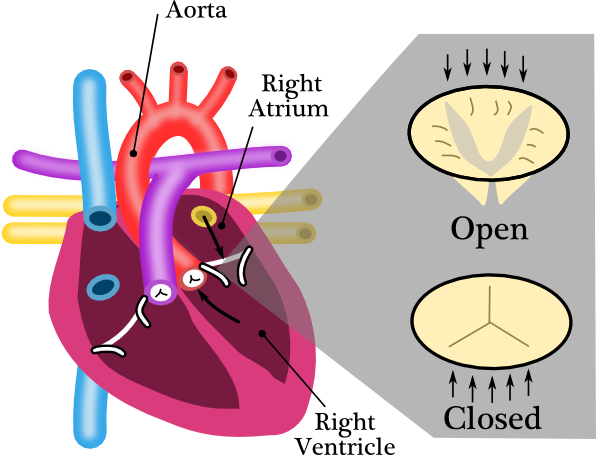As promised I though I would go into more detail of the best presentation, in my view, at the conference I traveled to. At the bottom of this article is the abstract of the presentation and references if you would like to know more. I have also put a disclaimer. WARNING pics may not be to everyones liking.
So let me try break the problem down for you and hopefully convert it into some easy to understand chunks.
The Heart Valve:
In your heart you have valves that open and close at just the right time to allow your heart to pump the blood through your body.

Picture of the heart and a tricuspid valve (Picture generated by me)
The valve in question in this research is the tricuspid valve the tri indicating three parts to the valve. Think about how a one way cat door works; apply pressure on one side it will open but pressure on the other side will close it. When the right atrium contracts, it puts a large amount of pressure on this valve and it opens filling up the next compartment. Then when the right ventricle contracts to pump the blood the valve is forced closed because it is a one way valve.
Now think of a really terrible valve that doesn't seal properly. That is called Tricuspid regurgitation it is defined as a leakage of blood backwards through the valve each time the right ventricle contracts instead of pumping the blood to the body via the aorta.
There are many reasons for this issue and it is estimated 300,000 annual replacements worldwide. Pediatric patients in particular are faced with a lifelong risk of valve-related morbidity and up to 50% reduction in life expectancy. There are three main options for a patient:

Info-graphic Options for Tricuspid regurgitation (Picture generated by me, valve from sourse)
Now as you can see there are definitely advantages to each of the options. The tissue valve (also known as a bioprosthetic valves) would be the best option if only it didn't have a life span so this is where research comes in.
Frank Baaijens of Technische Universiteit Eindhoven is one of the researchers that have been investigating the issue of why heart valves break down over time looking at their major causes. More interestingly though they are 'growing' their own valves!

I do not own this pic. It is taken from a journal article (see refs).
What you are looking at is a cultivated heart valve which was grown in a mold and then cut for the openings. The reason for the mesh like structure is to spring into place inside the vessel and support cellular growth to the valve. As you can expect there was many problems with growing such a valve.

Different types of break downs. Again I do not own this pic. It is taken from a journal article (see refs)
What I find fantastic about this research is how many different components are brought together. To understand what was happening they use computer simulated models of the valve taking into account valve geometry, material properties, and hemodynamic loads.

Again I do not own this pic. It is taken from a journal article (see refs)
These 'grown' valves have been tested in sheep and the research is ongoing. I am fascinated with this research and if you ever get a chance to watch one of his presentations do it. You will not regret it. I wish I knew more to share with you but I have my own research to get to!
Further Reading Material:
Abstract:
IC4 Rational Design of Tissue Engineered Heart Valves
Frank Baaijens, Technische Universiteit Eindhoven, The Netherlands
"Valve replacement with mechanical or bioprosthetic prostheses is the most common intervention for valvular disease, with almost 300,000 annual replacements worldwide. However, in particular in patients younger than 18 years freedom from reoperation is only 58-68% at 15 years. Tissue engineering of living heart valves seeks to overcome these limitations. One of the most critical problems in heart valve tissue engineering is the progressive development of valvular insufficiency. In an effort to resolve this challenge, a computational model was developed to predict the in vivo remodeling process in tissue engineered heart valves subjected to dynamic pulmonary and aortic pressure conditions, and to assess the risk of valvular insufficiency"
Disclaimer:
I do not own any of this work it has been attributed to the presenter and whilst I make all effort to be correct I do not grantee it is. I am in no way connected to his work (although I do wish to be) and my views are not representative of his. I do not normally research this topic but found it interesting. What I have done is combined some of his literature into an easily understandable review.
References:
Abstract
American Heart Association
Valve Pic
Paper 1
Paper 2
Website
Edit: Tags #steemstem
#steemstem tag should help here, for more traction.
https://steemit.com/steemstem/@steemstem/helpful-guidelines-for-crafting-steemstem-content
This is their 'flyer':
Thanks! It might be a bit late now but I will remember it for next time :)
Congratulations @me-shell! You have received a personal award!
Click on the badge to view your Board of Honor.
Do not miss the last post from @steemitboard!
Participate in the SteemitBoard World Cup Contest!
Collect World Cup badges and win free SBD
Support the Gold Sponsors of the contest: @good-karma and @lukestokes
Congratulations @me-shell! You received a personal award!
You can view your badges on your Steem Board and compare to others on the Steem Ranking
Do not miss the last post from @steemitboard:
Vote for @Steemitboard as a witness to get one more award and increased upvotes!